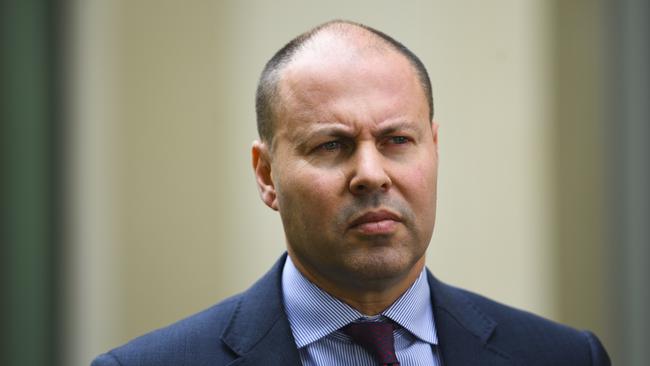Bull to bear in three weeks with market down 20pc as Trump leaves the world waiting
The four-year bull market in Australian shares is officially dead as fear of a global recession overwhelmed hope of stimulus.

The four-year bull market in Australian shares is officially dead as fear of a global recession caused by coronavirus overwhelmed hope of monetary and fiscal stimulus to combat the outbreak.
Amid disappointment over the lack of major US fiscal stimulus to fight the coronavirus, flagged by US President Donald Trump a day earlier, Australia’s S&P/ASX 200 share index dived 213.7 points, or 3.6 per cent, to a 14-month low of 5725.9 to be down 20 per cent in three weeks.
The financials sector was weakest with CBA down 6.6 per cent, NAB down 6.3 per cent, ANZ down 5.5 per cent and Westpac down 5.3 per cent amid renewed pressure on interest rates.
Australian 10-year bond yields fell 11 basis points to 0.68 per cent while the Aussie dollar steadied around US65c. S&P 500 futures were down 2.8 per cent when the Australian market closed.
As well as entering an official bear market by falling 20 per cent from its bull market peak of 7162.5 points three weeks ago, the local bourse saw its fastest-ever shift from bull to bear.
“The market has been hit with a mass of selling,” said Richard Coppleson, head of institutional sales and trading at Bell Potter. “The only question now is, when will it start to ease?”
The value of shares traded on Wednesday at $13bn was the fifth largest in history. That suggested there was a degree of capitulation by investors behind the sell-off.
It followed heavy buying on Tuesday amid hope of a major US economic stimulus package to offset the impact of the coronavirus pandemic. Tuesday’s volume of $16bn was the highest ever.
“In this sell-off we have had four of the biggest days out of 12 biggest in just the last nine days,” said Mr Coppleson.
“This volatility will go on for at least another month or two as so much uncertainty over this nastier than normal flu from China continues to dominate the headlines.”
Sharemarkets in Asia also came under pressure, although not as much as locally.
South Korea’s KOSPI fell 2.8 per cent, Japan’s Nikkei 225 fell 2.3 per cent, China’s Shanghai Composite dipped 0.9 per cent and the Hang Seng index fell 0.7 per cent.
Investors were also concerned by the spread of coronavirus as the number of US cases topped 1000.
“The first order of business is that in the US there needs to be comprehensive testing to arrive at a credible tally of cases, without which we have no way to quantify the effectiveness of the next point,” said AxiCorp chief market strategist Stephen Innes.
“That is, there needs to be a policy response perceived as reachable and productive to stop the virus spreading further and mitigate economic damage.
“Both could easily take another few weeks. The question is, can we stand another few weeks in COVID-19 purgatory with the markets on the precipice of a cliff edge?”
Late Wednesday the Bank of England slashed official interest rates by 50 basis points to 0.25 per cent — its first emergency cut since the global financial crisis — while also starting a new term funding scheme for small and medium-sized firms, and cutting its countercyclical buffer to zero to free-up cash for lending. The pound fell 0.8 per cent but the FTSE 100 was up 1.3 per cent in early trade.
While Mr Trump didn’t show at a White House press conference on Tuesday to detail the fiscal stimulus he flagged after the biggest one-day fall on Wall Street since the GFC, economic adviser Larry Kudlow left markets with some hope that a package will be announced soon.
“At some point in the near future we will outline a more detailed package,” Mr Kudlow said.
Meanwhile, the federal government in Australia confirmed it will unveil its first fiscal response to the coronavirus crisis and SkyNews reported that it will be worth $15bn to $20bn.
A $20bn stimulus would equate to about 1 per cent of GDP.
The package will include one-off cash payments of $500 for some welfare recipients, including pensioners and jobseekers, according to SkyNews.
It came as banks announced cuts to fees and payment deferrals for small business customers ahead of a meeting with Treasurer Josh Frydenberg in Sydney on Wednesday.
And the Westpac Melbourne Institute Consumer Confidence index sank to a five-year low in March.
US investment bank Citi said Australia would go close to a recession because of the coronavirus.
Chief economist Josh Williamson slashed growth forecasts to minus 0.25 per cent in the March quarter and zero in the June quarter, while lowering his year-average forecast to 1.7 per cent.
“Other things being equal, our GDP forecasts would require only a small further negative change in Q2 for Australia to enter a technical recession in the first half of the year,” he said.
He was assuming that the economic effects of the virus wane in the September quarter but he warned that the risk was it would take longer to fade, “implying downside to the yearly growth forecast”.
“We doubt that the government will want to be the first since the Hawke government in 1991 to experience a recession on its watch,” Mr Williamson said.
“Avoiding this outcome outranks the goal of achieving a budget surplus.
“This assumption suggests that the government will deliver a spending package that seeks to offset its estimate of the hit to growth from the virus.”




To join the conversation, please log in. Don't have an account? Register
Join the conversation, you are commenting as Logout